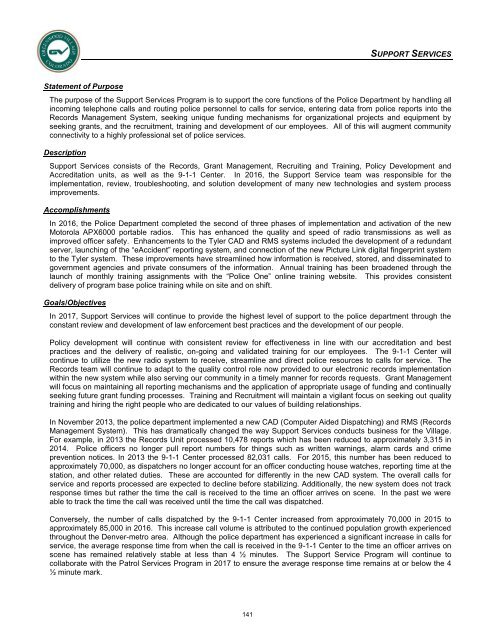Adopted 2017 Annual Operating & Capital Improvement Budget
Create successful ePaper yourself
Turn your PDF publications into a flip-book with our unique Google optimized e-Paper software.
SUPPORT SERVICES<br />
Statement of Purpose<br />
The purpose of the Support Services Program is to support the core functions of the Police Department by handling all<br />
incoming telephone calls and routing police personnel to calls for service, entering data from police reports into the<br />
Records Management System, seeking unique funding mechanisms for organizational projects and equipment by<br />
seeking grants, and the recruitment, training and development of our employees. All of this will augment community<br />
connectivity to a highly professional set of police services.<br />
Description<br />
Support Services consists of the Records, Grant Management, Recruiting and Training, Policy Development and<br />
Accreditation units, as well as the 9-1-1 Center. In 2016, the Support Service team was responsible for the<br />
implementation, review, troubleshooting, and solution development of many new technologies and system process<br />
improvements.<br />
Accomplishments<br />
In 2016, the Police Department completed the second of three phases of implementation and activation of the new<br />
Motorola APX6000 portable radios. This has enhanced the quality and speed of radio transmissions as well as<br />
improved officer safety. Enhancements to the Tyler CAD and RMS systems included the development of a redundant<br />
server, launching of the “eAccident” reporting system, and connection of the new Picture Link digital fingerprint system<br />
to the Tyler system. These improvements have streamlined how information is received, stored, and disseminated to<br />
government agencies and private consumers of the information. <strong>Annual</strong> training has been broadened through the<br />
launch of monthly training assignments with the “Police One” online training website. This provides consistent<br />
delivery of program base police training while on site and on shift.<br />
Goals/Objectives<br />
In <strong>2017</strong>, Support Services will continue to provide the highest level of support to the police department through the<br />
constant review and development of law enforcement best practices and the development of our people.<br />
Policy development will continue with consistent review for effectiveness in line with our accreditation and best<br />
practices and the delivery of realistic, on-going and validated training for our employees. The 9-1-1 Center will<br />
continue to utilize the new radio system to receive, streamline and direct police resources to calls for service. The<br />
Records team will continue to adapt to the quality control role now provided to our electronic records implementation<br />
within the new system while also serving our community in a timely manner for records requests. Grant Management<br />
will focus on maintaining all reporting mechanisms and the application of appropriate usage of funding and continually<br />
seeking future grant funding processes. Training and Recruitment will maintain a vigilant focus on seeking out quality<br />
training and hiring the right people who are dedicated to our values of building relationships.<br />
In November 2013, the police department implemented a new CAD (Computer Aided Dispatching) and RMS (Records<br />
Management System). This has dramatically changed the way Support Services conducts business for the Village.<br />
For example, in 2013 the Records Unit processed 10,478 reports which has been reduced to approximately 3,315 in<br />
2014. Police officers no longer pull report numbers for things such as written warnings, alarm cards and crime<br />
prevention notices. In 2013 the 9-1-1 Center processed 82,031 calls. For 2015, this number has been reduced to<br />
approximately 70,000, as dispatchers no longer account for an officer conducting house watches, reporting time at the<br />
station, and other related duties. These are accounted for differently in the new CAD system. The overall calls for<br />
service and reports processed are expected to decline before stabilizing. Additionally, the new system does not track<br />
response times but rather the time the call is received to the time an officer arrives on scene. In the past we were<br />
able to track the time the call was received until the time the call was dispatched.<br />
Conversely, the number of calls dispatched by the 9-1-1 Center increased from approximately 70,000 in 2015 to<br />
approximately 85,000 in 2016. This increase call volume is attributed to the continued population growth experienced<br />
throughout the Denver-metro area. Although the police department has experienced a significant increase in calls for<br />
service, the average response time from when the call is received in the 9-1-1 Center to the time an officer arrives on<br />
scene has remained relatively stable at less than 4 ½ minutes. The Support Service Program will continue to<br />
collaborate with the Patrol Services Program in <strong>2017</strong> to ensure the average response time remains at or below the 4<br />
½ minute mark.<br />
141


















